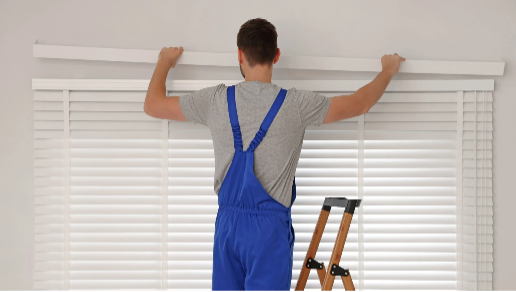
When choosing window blinds, there’s more to consider than just their design. Whether using horizontal or vertical blinds, you’ll need to determine where on the window frame to install them. Should your blinds go inside or outside the window frame? Selecting the right option can impact your space’s overall look and functionality. Here we the advantages and disadvantages of both mounting types to help you make your decision.
Inside-Mounted Blinds
Inside-mounted blinds are installed inside the window frame rather than on the wall or outside. When opting for inside mounting, the blinds and their operating mechanisms fit snugly within the window recess, allowing the window to take centre stage without covering its edges.
By fitting snugly within the window frame, inside-mounted blinds create a seamless integration with the window, enhancing the overall aesthetic appeal of the space and creating a polished and sophisticated look. Inside mounting allows complete window exposure when raised, allowing natural light to flood the room and providing an unobstructed view of the outdoors. This feature is particularly beneficial in spaces with beautiful scenery or when you want to maximise the amount of natural light entering the room.
Inside-mounted blinds are also an excellent choice for showcasing decorative window trims and mouldings. By leaving the edges of the window exposed, these blinds highlight and accentuate any architectural details around the window, adding a touch of elegance and charm to the interior decor. Whether you have uniquely designed window trims or intricate mouldings, inside-mounted blinds beautifully frame and complement these features, elevating the overall visual appeal of your living spaces.
While there may be potential fitting challenges for windows with irregular shapes or obstructions, precise measurements and proper installation will prevent gaps or unevenness that could compromise their functionality and aesthetic appeal.
Outside-Mounted Blinds

Outside-mounted blinds refer to window blinds installed on the wall or above the window frame rather than inside the window recess. They cover the entire window area, including the frame, and often extend beyond the window edges to provide additional coverage.
Since they cover the entire window area, outside-mounted blinds provide enhanced light blockage and leave no gaps for light to seep through. This feature is especially beneficial in bedrooms, media rooms, or spaces that require increased privacy and reduced sunlight. They are excellent for hiding unattractive window frames and providing a more significant visual impact. Extending beyond the window edges creates a clean and polished look, making the window and the room appear larger and more sophisticated. This is particularly advantageous when dealing with older or less aesthetically pleasing window frames.
Outside-mounted blinds also offer easier installation for windows with limited depth or obstructions that may hinder inside mounts. You can conveniently mount them on the wall or above the window frame, allowing for a seamless and efficient setup.
Factors to Consider
When it comes to deciding if your blinds should go inside or outside your window frame, there are several factors you must consider:
- Window type and design: Inside-mounted blinds may be more suitable for windows with deep and recessed frames, while outside-mounted blinds may be more practical for windows with limited depth or unconventional shapes.
- Decorative elements and architectural features surrounding the window: Inside-mounted blinds are ideal for showcasing decorative trims and mouldings. In contrast, outside-mounted blinds can hide unattractive frames and provide a more polished look.
- Light control, privacy, and insulation: Outside-mounted blinds offer enhanced light blockage and privacy, making them suitable for bedrooms or media rooms, whereas inside-mounted blinds may provide a cleaner and streamlined appearance.
- The right measurements: Accurate window measurements and depth are critical for proper fit and functionality. Ensure that the selected blinds are tailored to precisely fit the window frame, avoiding any gaps or obstructions that could affect their performance.
Create the Perfect Blinds, Customised to Suit Your Windows
By carefully weighing the features that both blind mounting options can offer, you can make an informed decision that perfectly complements your windows, enhances the overall room ambience, and meets your functional requirements for a stylish and effective window treatment solution.
NZ Blinds has over 30 years of experience in the window covering industry, specialising in custom-made blinds to suit any window mount type. Whether you’re seeking a sleek and minimalistic appearance or greater light control and privacy, we have options to suit your needs. From versatile roller blinds to gorgeous Venetian blinds, shop online now to create the perfect window treatment for your home.